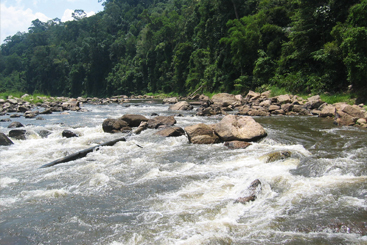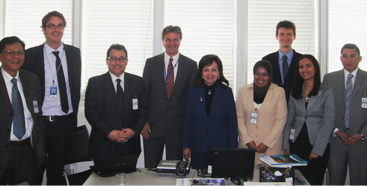Sungai Perak: a special river
With the new sub-basin management plan for the Tisza, the Tisza Group and the
countries of the Tisza River Basin have achieved significant progress and an outstanding
example of cooperation.

Sungai Perak: a special river
Though small compared with the Danube, the Malaysian river shares much with the Danube; both rivers are rich in culture and history, both supply water for life and living, and both face issues of equity, floods, water quality and environment.


The famous Royal Belum is a 110,000 ha tropical forest reserve rich in biodiversity.
Sungai Perak is the 'River of Life' for Perak State in Malaysia. It flows over 400 km in a 15,000 km2 catchment that covers 70% of the state lands. The second longest river in Peninsular Malaysia, it starts from the north-western corner of the state, flows south to Teluk Intan, where it bends westward and into the Straits of Malacca. The river divides the state into two nearly equal halves and thus forms its natural backbone. And this river of life is special in many ways.
Sungai Perak is special for its Royal Stature. History recorded that whoever controls Sungai Perak has authority over the state. This adage still holds true and His Majesty the Sultan of Perak still resides in the Royal Town of Kuala Kangsar on the bank of the river. This river is central to the history and traditions of Perak Sultanate and the people; its waters are part of royal ceremonies including the investiture of a new Sultan.
A working river rich in biodiversity. Sungai Perak is special for its wide spectrum of functions and is perhaps the only one in Malaysia that performs nearly all the functions expected of a river. The first rubber trees in the country were planted on the riverbanks, and its waters irrigate a national paddy granary and produce hydropower for the nation.
The river is also special for its nature and beauty. The famous Royal Belum is a 110,000 ha tropical forest reserve rich in biodiversity. Elephants and tigers still roam freely here. A river terrapin conservatory established in 1960 at Bota Kanan, remains one of few of its kind in the world. The lakes in the upper stretches are simply beautiful. Quaint traditional kampungs (villages) still exists between modern towns including Teluk Intan with its own 'Leaning Tower'.
For all its special qualities, Sungai Perak still needs 'something special' to survive in a rapidly changing economy. Sungai Perak needs good care to remain special forever, for future generations. Otherwise, as in many rivers, it will deteriorate gradually, unnoticed, until in a critical state.
Taking action before it's too late. The Perak State Government has taken a bold and innovative step to avoid such situations through an Integrated River Basin Management (IRBM) Project initiated by the public-private sector – fundamentally to instil the spirit of 'love and care for rivers' before it is too late. The project master plan is expected by August 2011.
The Danube has been identified as a model for the project, and the Project Steering Committee sent a delegation to meet the ICPDR Secretariat to learn about managing the Danube. The Steering Committee Chairperson, Her Royal Highness Raja Nor Mahani Raja Shahar Shah, led the delegation, which included Hamidah Osman, the State Executive Councillor for Tourism; Abdul Razak Dahalan, Technical Committee Chairperson; and Aminudin Zaki Hashim, CEO of Darul Ridzuan Institute for Development Strategies and Her Highness Raja Azwina.
Learning from the Danube. The delegation met the ICPDR Secretariat on 5 May 2011 for an in-depth briefing. The delegation was impressed with the achievements of the ICPDR, and especially that the many countries involved could agree on a common reference for the good of the river and basin communities.
"If 14 Countries can agree on how best to manage a river [Danube]," said HRH Raja Nor Mahani, "then it should be relatively easier to manage one river [Sungai Perak] flowing through five districts in one state of a country."
The ICPDR's public participation programmes, and especially Danube Day, impressed the delegation, and all agreed that monitoring the environment is an effective strategy for managing rivers. "It's all about quality," said Hamidah Osman, "river quality, riverfront quality, environmental quality and service quality."
Getting the public involved. HRH Raja Nor Mahani explained that, ultimately, the Sungai Perak IRBM Project seeks to install an integrated management system for Sungai Perak with strategies that provide economic opportunities and benefits to all in a revitalised river with tourism as the main theme. All stakeholders need to be excited about the plan and with the feeling of there being real connections between the river and the people.
The delegation joined a river cruise on the Danube to study its life and living environment and noted spaces for parks and bike trails, riverfronts, island development and quality. "Having adequate space for public facilities all along the riverbanks encourages stakeholders' participation and love for the river," said Abdul Razak.
 A delegation from the Project Steering Committee visited the ICPDR Secretariat to learn about managing the Danube. Pictured (from left): the author, Raimund Mair, Abdul Razak Dahalan, Philip Weller, HRH Raja Nor Mahani, Hamidah Osman, Benedikt Mandl, HH Raja Azwina and Aminudin Zaki Hashim.
A delegation from the Project Steering Committee visited the ICPDR Secretariat to learn about managing the Danube. Pictured (from left): the author, Raimund Mair, Abdul Razak Dahalan, Philip Weller, HRH Raja Nor Mahani, Hamidah Osman, Benedikt Mandl, HH Raja Azwina and Aminudin Zaki Hashim.
Overall, the meeting with ICPDR Secretariat and the Danube experience far exceeded initial expectations. The Danube is an appropriate model and, more importantly, establishing ties with the ICPDR Secretariat will result in mutual benefits. HRH Raja Nor Mahani invited the ICPDR Secretariat to visit Sungai Perak and indicated plans for more delegations from Malaysia.
"Our rivers may differ in terms of size, but we all share the same vision: clean, living and vibrant rivers for the future generations of the world," said HRH Raja Nor Mahani.
Mohd Adnan is a professional engineer and the Managing Director of Corak Zaman Sdn. Bhd., the private sector partner to the Government of Perak for the Sungai Perak IRBM Project.





